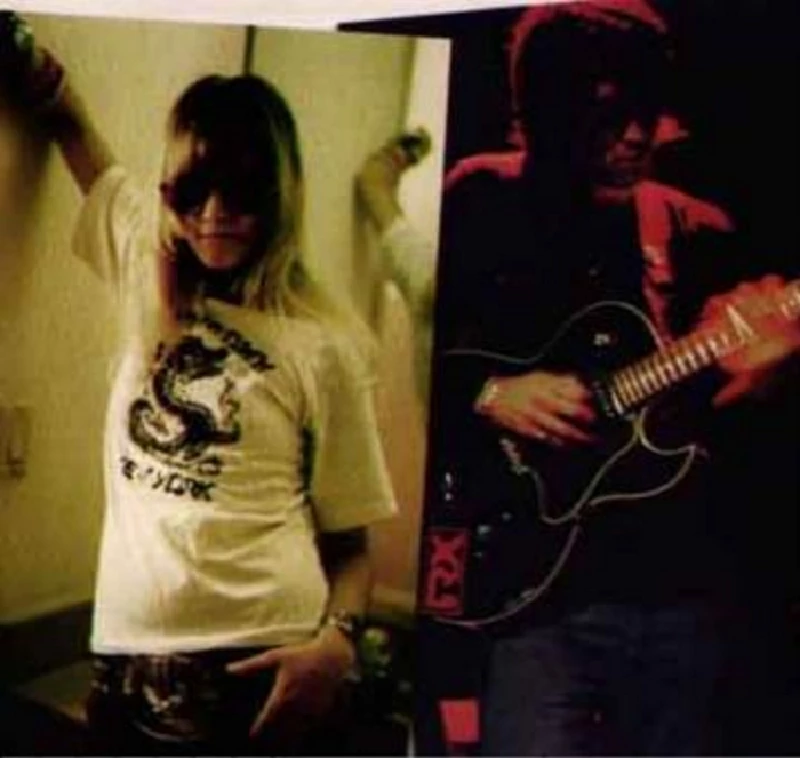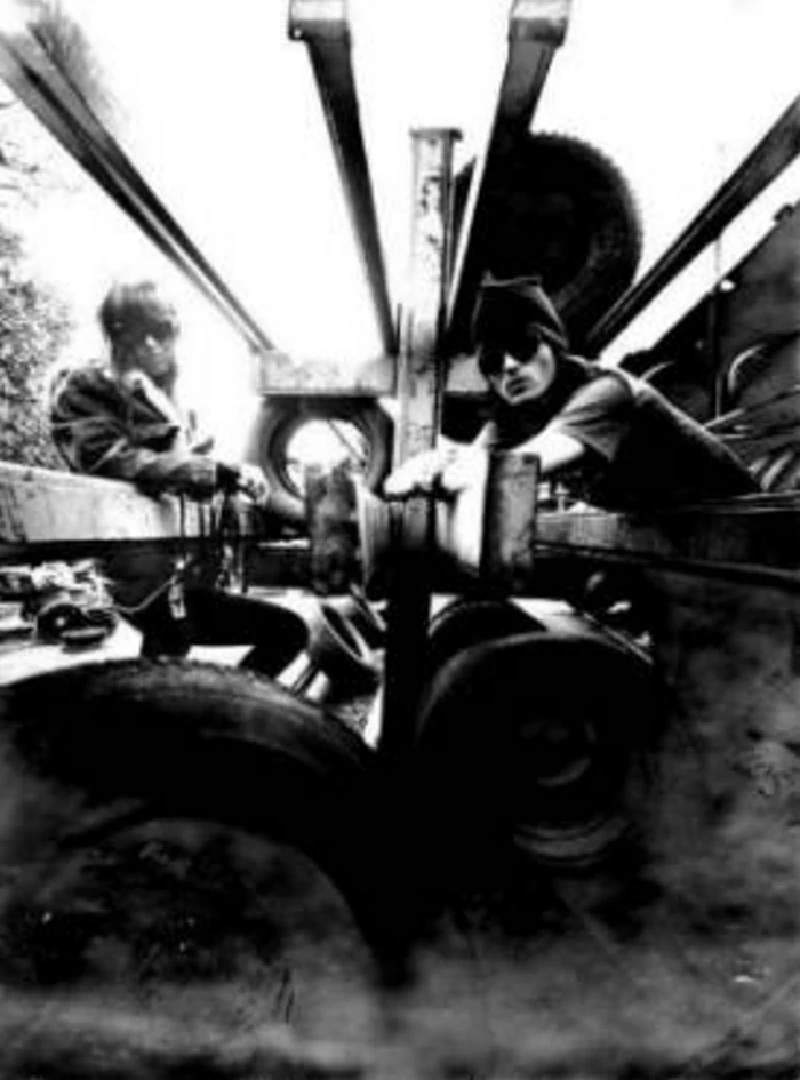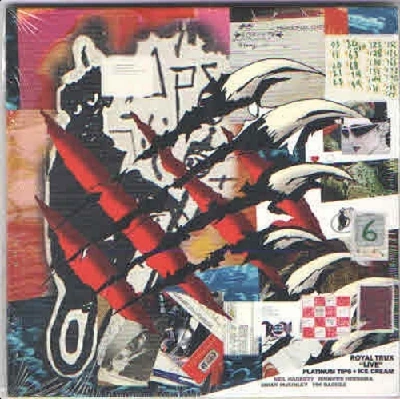Royal Trux - Profile
by Andrew Carver
published: 12 / 5 / 2003

intro
Beginning "as a musical shambles", and dying as "a hard-riffing rock machine", Royal Trux over the course of 14 years recorded 10 albums. Andrew Carver looks back on their prolific career
Royal Trux began life as a musical shambles, and died as a hard-riffing rock machine. Along the way, the band embraced drugs, death and depravity; demanded obscurity and flirted with major-label fame. Their live shows ranged from disaster to brilliance. Many artists have been encumbered with the cliched praise “They did it their way”, but few have deserved it as much as Royal Trux. For a band disinclined to stick to a beaten path, Royal Trux have a fairly identifiable career arc: From incoherent outsider art, to a more condensed (but still haphazard) take on 70’s rock, to a relatively polished major label presence, to a final mixture of the three previous phases, with emphasis on the second. As rock destroyers Pussy Galore began to inch toward dissolution, guitarist Neil Hagerty and his girlfriend Jennifer Herrema began experimenting with tapes and general sonic malfeasance. The first full-length and self-titled fruit of their work together appeared in 1988 on the group’s own Royal Records (it was re-released five years later on Drag City). Hagerty and his new partner in crimes against music seemed to be taking their cues from Jandek circa ‘Interstellar Discussion’ instead of the demolition of the Rolling Stones that guitarist Hagerty had made his name with in Pussy Galore. Misshapen fuzz guitar, scratched strings, inept percussion that forgets where it’s going every two bars, Herrema squeezing the words on her numbers out like pus from a wound and Hagerty hollering “Bad blood is gonna fall on you ... bad blood, bad blood ... is gonna fall all over you,” on the lead-in track (named, of course, ‘Bad Blood’) .... ‘Royal Trux’ wasn’t particularly compelling stuff, sounding like the bits and pieces of random strumming and riffing that other bands would leave on the editing studio floor — stuff they did warming up before and between takes except on those occasions when the band thought to play guitar, drum and sing at the same time: On ‘Zero Dok’ things began to come together (or at least, they drifted apart a little less wilfully than on other “songs”), but for the most part, Royal Trux’s first album sounds like music concrete for dopers — a staggering mental patient of an album. Their second album is even less together — twice as long, and possibly twice as f***ed up. .’Twin Infinitives’ is a tribute to the power of drugs to make anything sound good to the person making the noise in question: Tuneless hollering from Hagerty, slurred murmuring from Herrema and zapping noises apparently hijacked from a computer game open the album ... the sounds generated could be made into a song, but none of the elements seem to be operating at the same speed. On ‘Jet Pet’ the fuzzy guitar, squelching break beats and Herrema’s chanting of “Yeah-yeah, hey-hey!” have their own independent charm, but the fact that they’re in the same song seems like an accident. Like its predecessor, it has its own demented charm, but for the most part its an experiment that doesn’t demand repeating (except perhaps as a sonic companion for compulsive readers of William S. Burroughs and Hunter Thompson). Royal Trux’s latest release ‘Hand of Glory’ comes from around this period. Their “lost” album — actually recorded between 1985-1989 in Washington D.C., NYC and San Francisco — is as bonkers as its predecessors. The sound seems fuller and cleaner, as in the albums to come, but the incoherence is strictly early Trux. The vocals on the first song, ‘Domos Des Burros’, seem to be cribbed from three different sources. One harmonica bleats while another squalls. A vaguely Latin beat underpins some other song. A piano is plunked, a guitar is twanged. The second track, a five parter entitled ‘The Boxing Story’; commencing with ‘Electric Boxing Story’ starts with a high pitched electric flute, long scraping runs on some bowed instrument, chipmunk vocals — there’s a lot of speeded-up vocals throughout — bleeps’n’bloops. What relevance the section titles — ‘Four Kings’, ‘Golden Lament’, ‘Pots and Pansy’ and ‘K-9 to the Core’ — have to the music itself is unknown ... one can imagine the Drag City label telling the terrible two to get it together and squirrelling the tapes away. Royal Trux themselves seemed to realise cohesion was sorely missing from their albums, and on the second “Royal Trux” (released as catalogue No. DC10 — their first self-titled album is DC5), they woke up and grabbed it, ushering in the second stage of their careers. ****** “Air, air, air, I love you ... air, air, air she needs it too.” An electric guitar lazily follows Hagerty’s flattened folk strumming, the drumming is perfunctory, but ‘Air’, the first track on’Royal Trux’ is the first time the band sounds like they’re trying to synchronise things — not terribly well, but the effort is there. There are shambolic harmonies and a fumbling stab at counterpoint in the vocals. Hagerty makes excellent use of his upper register (by comparison, Herrema’s declamatory growl is not quite there on ‘Hallucination’). The greatest improvement comes in the guitar: Most songs have two guitars working at the same time, lending a fuller sound, and Hagerty’s leads frequently attain an acid-scorched glory. The acoustic ‘Junkie Nurse’ could come from a rough-hewn hillbilly 78 from the 20s, at least musically. Yes, the Trux stumbled and crawled through some of the numbers, but ‘Royal Trux’ was a genuine try at musicality, with tunes one might actually make an attempt to sing along with. Their fourth album, ‘Cats and Dogs’ is undeniably the best of their early work; some call it the high point of their career. The album’s tempo is slightly somnolent — The Rolling Stones’ ‘Exile on Main Street’ immediately leaps to mind as a possible inspiration, but one from a universe where the blues scale (and for that matter, the major, minor, myxylodian, aeolian, locrian scales) is unknown. More is more with Royal Trux, as half a dozen elements exist side by side on several songs — extra musicians help Herrema and Hagerty round out the album. The instruments and voices do not always line up with each other, but they all seem to be on the same page, and rarely crowd one another. The restrained ‘Turn of the Century’is the ideal example: Dislocated slide guitar, a delicate sequence of piano notes, cymbal tapping, Hagerty and Herrema speak-sing the lyrics out of sync (as they do on several tracks). By comparison, ‘Friends’ is a wordless fuzzbomb with sharp, rapid-fire picking zipping back and forth overhead. Once again, Hagerty’s soaring, crashing lead work is an album highlight, varying from birdsong to bong-huffing fuzz, sometimes in the same song. ‘Cats and Dogs’ can be called a rock album, but it still has the twists and turns of their earlier work. Royal Trux were still a band that could pride themselves on their unpredictability — particularly after their next move. ***** Trux watchers might have been alarmed by news of a drug overdose or sudden meltdown, given the band’s notorious habits, but they were genuinely surprised when Hagerty and Herrema signed to a major label, Virgin Records. (That the band would sign, or that a label would have them, would have been amazing enough by itself ...) Was the label thinking of their coup with the Sex Pistols, another unruly band, a trophy to confirm its excellent taste ... did label A&R personnel imagine they were getting their own Jon Spencer Blues Explosion? Perhaps another Nirvana? The band’s first record showed an obvious influence of big league money: ‘Thank You’ was produced by Dave Briggs, best known for his work with Neil Young, and has a clean, thick production not particularly suited to the Royal Trux aesthetic of organised chaos. Hagerty’s guitar work leans more heavily on chords than single notes, and his leads seem confined to a box. It does have a tighter group of songs — only closer ‘Shadow of the Wasp’ is longer than four and a half minutes — and Herrema’s rasp has come into its own; the mood is reminiscent of the Velvet Underground’s ‘I’m Waiting for My Man’. Briggs’ death left Herrema and Hagerty to produce their next album, ‘Sweet Sixteen’ themselves (as Adam and Eve the duo have produced albums for such underground notables as the Make-Up and Brother JT). ‘Sweet Sixteen’ is generally regarded as the band’s worst “late-period” work, but with the passage of six years it’s hard to see why it received the critical drubbing it did in some quarters; it’s hardly the “contractual obligation” effort it’s sometimes described as. (Some critics also complained that ‘Sweet Sixteen’ was occasionally too long and unfocused ... where were these people when ‘Twin Infinitives’ came out ?) Misguided criticism aside, ‘Sweet Sixteen’ is a must for Trux fans just for the wah-wah lead that opens ‘Morphic Resident’ alone. ‘10 Days 12 Nights’ and ‘I’m Looking Through You’ also motor along. ‘Sweet Sixteen’ was the last album the band did for Virgin; they were dismissed by the label after Virgin realised that the greater record-buying public would never warm to Royal Trux , regardless of how “radio-ready” (not very!) their music was made. In hindsight, a lot of the album seems to reflect a kiss off to Virgin, starting with perhaps the most disgusting cover artwork in the history of major label releases (a toilet clogged with toilet paper and reddish-brown goop), and having song titles — ‘Don’t Try To Hard’ was the opener — and lyrics which reflected an independent streak, e.g., “I’m packing my bags, I’m Tunica bound” on ‘Golden Rules’ and “Holding fifteen hundred in cash, trying to move in on us, I got a bird in my hand and no time to talk,” in ‘Can’t Have it Both Ways.’ There’s also an occasional dose of audience-baiting weirdness, such as the electronic noise at the start of the title track — which ends with Hagerty yelling “Someone’s gotta pay!” (and snickering). Soon enough, lugging a vast sum of Virgin’s money, the band was headed back to Drag City. ***** At about the same time Drag City released ‘Singles, Live, Unreleased”’, a vital overview of the band’s 1988-94 work for the label, as well as material recorded for labels like Velocity and ROIR. The material recorded for the BBC is particularly good. The Peel Sessions versions of ‘Royal Trux’s No. 1’s“Esso Dame’ is changed from a stumbling smack hound to growling street fiend; also choice is a melodic, straight-faced cover of Milton Nascimento’s ‘Fe Cega Faca Amolada’ (apart from putting to rest any foolish rumours that Hagerty can’t play guitar well, it also reveals an interest in Tropicalia and South American rhythms which was becoming more evident in the band’s work at this point — Royal Trux may be the only band equally influenced by Tito Puente and smack). The compilation hops back and forth without respect for chronology, but there’s little chance even a casual listener would believe ‘Steal Your Face’ (a Sub Pop single, paired with ‘Gett Off”’) and the mellow ‘Back To School’ from 1992, were recorded in the same year (or state of mind) as the sinister, reverberated heroin ode-come-nursery rhyme ‘Spike Cyclone’ from 1988. 1990’s ‘Vile Child’ may be the birth of glitch. The band expertly covers Jefferson Airplane’s ‘Law Man’ (the flip of the appropriately drugged ‘Red Tiger’). The Godz also get a cover, ‘Womban’, resurrected from a various artists tribute album, ‘Godz Is Not A Put On" to the 1960s ESP recording artist weirdos. ‘Mercury,’ an unreleased track from their last session for Drag City, has some of the most roughshod caterwauling ever committed to magnetic tape. In ‘No Fixed Address’, an early single from 1989 another jury rigged riff repeats and repeats and repeats ... ‘Lucy Peaupeaux,’ a ‘Twin Infinitives’ outtake, sounds like a song from Ween’s’Chocolate and Cheese’ being beaten to death while Royal Trux do bad karoake over top. The band roundly sassed the funkadelic, sampled ‘Shockwave Rider’ in an interview in Puncture magazine (#42, 1998), but it’s still a groovy, Muggs-like trip. Among the oddities are the sax-focussed free jazz tribute’“Chairman Blow’ and ‘Cut You Loose’, a delicate voice-and-piano solo effort from Neil, juxtaposed against the prescient guitar distortion showcase ‘Baghdad Buzz’. With that closet cleaning out of the way, Royal Trux released their punchiest album yet: ‘Accelerator’ kicked off with the ultimate show-starter ‘I’m Ready’, which featured bass drum thump, driving riff and Herrema’s sneering “Now you know I’m ready!” Recorded live by Paul Oldham (brother of Will ... does that make him Prince Paul?) then overdubbed by Herrema and Hagerty, ‘Accelerator’ combines the live heft of a kicking band with post-production mutation. Far from the one-thing-at-a-time beginnings, every crevice in the band’s sound has been jammed with something. The album is simultaneously huge and ramshackle. Streaks of something like remorse show up, leavening the band’s more thrusting tracks — the sarcastic ‘The Banana Question’; lubricious ‘Juicy, Juicy, Juicy’ and others— with the downbeat ‘Yellow Kid’; ‘Stevie’ (both, it seems, tributes to a departed friend), and ‘Another Year’. ‘New Bones’ is noteworthy for its piercing leadwork, but the entire record overwhelms — a band high point, to be sure. The album’s British single ‘Liar” was released with a trio of B-sides, including a rocking version of Dire Straits’ ‘Money for Nothing’, ‘P.T. 20’ an echoing tone over a throbbing rhythm and ‘Mr. Crump Don’t Like It’ — Trux gone rockabilly trio, with Sun Records slapback is taken to extreme (it sounds like it was recorded in a watertank). The latter two cheerfully confirm that Royal Trux is still fooling around. ‘Money for Nothing’ is a great example of how a cover should be done: The composition is pumped up by Latin hand percussion. Without manhandling the tune to excess, Hagerty and Herrema’s vinegary vocals replace Mark Knopfler’s wondering drawl, turning an ordinary Joe’s amazement at the decadent r’n’r lifestyle to the knowing insiders’ derision. At the same time as ‘Accelerator’ was recorded, Royal Trux laid down three orphan tracks, which skipped the overdubbing of ‘Accelerator’ and collected them on ’3-Song EP’. The songs aren’t as punchy as the LP’s ... there is more of the narcotic side of the Trux in ‘Deafer Than Blind’ a short, slow groover. They bare their vehicular fascination with the seven-minute opus ‘The United States vs One 1974 Cadillac El Dorado Sedan’. Their next full-length ‘Veterans of Disorder’, doesn’t have the immediacy of ‘Accelerator’, though its opener, ‘Waterpark’, comes as close to the kickstart of ‘I’m Ready’ as any song can be fairly expected to. The album then eases into the pot-smoking (i.e. mellow but paranoia-inducing) groove of ‘Stop’ , then an easy-going relative to ‘Juicy, Juicy Juicy’, ‘The Exception’. The riffs on ’Veterans of Disorder’ are tight — at least at the album’s start — anchored by the drumming of long-time collaborator Ken Nasta. There’s an increasing dedication to percussion, first noticeable on ‘Accelerator’: Congas, cabasas, cowbells, timbales tom-tom, bells, cymbals, shakers, blocks ... for the single live show by Royal Trux that I was fortunate enough to witness, shortly before the release of ‘Veterans of Disorder’, the band had a pair of drummers in tow to help replicate the rhythm parts (they also drew flute and snake charmer duty). “The jaunty ‘Lunch Money’ on ‘Veterans of Disorder’ is about as far from the sound on ‘Twin Infinitives’ that Royal Trux ever got ... but then there’s ‘SickAzz Dog’, which starts off as one of Royal Trux’s sound jumbles. It occasionally slips into a snippet of song, including a “Hey,hey, hey” chorus at the halfway point, and some la-la-la polyphony. It could be several attempts, in different styles, of the same song (I’ll plump for the hearty, rhythm-and-white-noise version that emerges in the last 45 seconds). ‘Coming Out Party’ has a Bob Dylan feel — something circa ‘Mr. Jones’, say, with an in-your-face Herrema vocal and some out of touch guitar strumming and piano jangling in the back. It wouldn’t be out of place on ‘Cats and Dogs.’ ‘Blue Is The Frequency’ concludes the album with a slightly more coordinated nine-minutes, much of it dominated by a direct, cutting Hagerty solo. Royal Trux’s last full-length (barring ‘ the re-release of ‘Hand of Glory’ in 1992) was ‘Pound for Pound’. The title, according to the liner notes, derives not from any particular value by weight, but the drumming on the first track, where the beat anchors the guitar chords for extra punch. ‘Pound for Pound’ is a good album, but there does seem to be a slight exhaustion of ideas in a way that wasn’t the case for earlier albums. Though they may do it better, they don’t do anything they haven’t done before. Almost every song sounds like an echo of what went before. Herrema and Hagerty’s personal and musical partnership split soon after, with Hagerty putting out a pair of solo albums in quick succession and working on ‘A Drag City Supersession’ and ‘Weird War’ with various other artists. His third solo album is out imminently as of this writing.
Band Links:-
https://en-gb.facebook.com/royaltruxx/https://www.fatpossum.com/artists/royal-trux/
https://www.instagram.com/therealroyaltrux/
Picture Gallery:-


soundcloud
reviews |
|
Live - Platinum Tips + Ice Cream (2018) |

|
| Excellent live 'best of' from Neil Hagerty and Jennifer Herrema who after fifteen years apart reformed Royal Trux for gigs in New York and LA. |
most viewed articles
current edition
Carl Ewens - David Bowie 1964 to 1982 On Track: Every Album, Every SongArmory Show - Interview with Richard Jobson
Colin Blunstone - Thalia Hall, Chicago, 16/7/2025
Bathers - Photoscapes 1
Visor Fest - Valencia, Spain, 26/9/2025...27/9/2025
Billie Eilish - O2 Arena, London, 10/7/2025
John McKay - Interview
Robert Forster - Interview
Loft - Interview
the black watch - Interview
previous editions
Heavenly - P.U.N.K. Girl EPManic Street Preachers - (Gig of a Lifetime) Millennium Stadium, Cardiff, December 1999
Oasis - Oasis, Earl's Court, London, 1995
Paul Clerehugh - Interview
Trudie Myerscough-Harris - Interview
Beautiful South - Ten Songs That Made Me Love...
Pixies - Ten Songs That Made Me Love...
Prolapse - Interview
Doris Brendel - Interview
Simon Heavisides - Destiny Stopped Screaming: The Life and Times of Adrian Borland
most viewed reviews
current edition
Amy Macdonald - Is This What You've Been Waiting For?Sick Man of Europe - The Sick Man of Europe
Phew, Erika Kobayashi,, Dieter Moebius - Radium Girls
Alice Cooper - The Revenge of Alice Cooper
Davey Woodward - Mumbo in the Jumbo
Lucy Spraggan - Other Sides of the Moon
Blueboy - 2
Cynthia Erivo - I Forgive You
Vinny Peculiar - Things Too Long Left Unsaid
Philip Jeays - Victoria
Pennyblackmusic Regular Contributors
Adrian Janes
Amanda J. Window
Andrew Twambley
Anthony Dhanendran
Benjamin Howarth
Cila Warncke
Daniel Cressey
Darren Aston
Dastardly
Dave Goodwin
Denzil Watson
Dominic B. Simpson
Eoghan Lyng
Fiona Hutchings
Harry Sherriff
Helen Tipping
Jamie Rowland
John Clarkson
Julie Cruickshank
Kimberly Bright
Lisa Torem
Maarten Schiethart